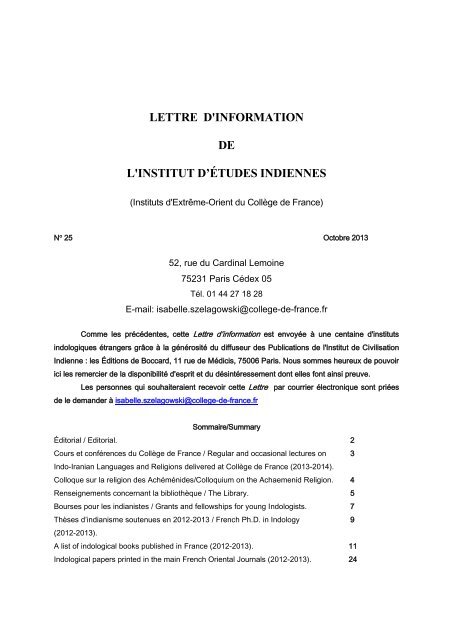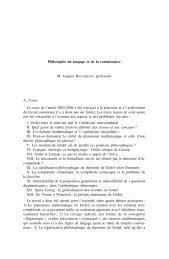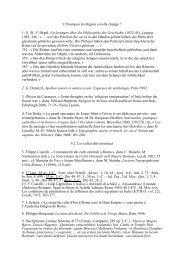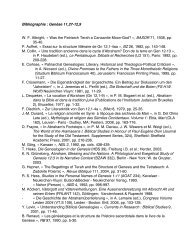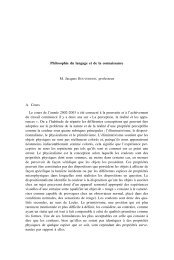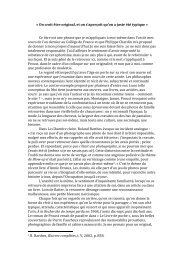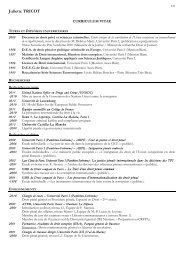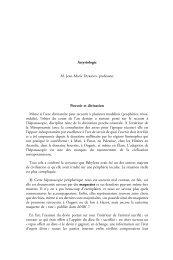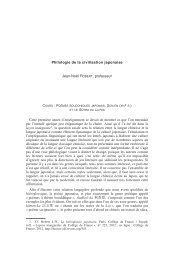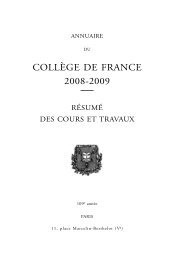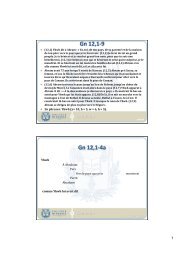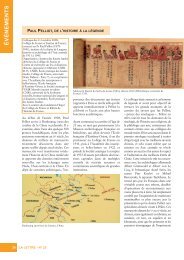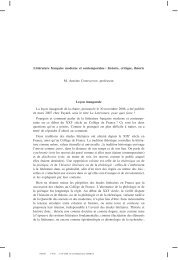Lettre d'information N° 25, octobre 2013 - Bibliothèques Archives
Lettre d'information N° 25, octobre 2013 - Bibliothèques Archives
Lettre d'information N° 25, octobre 2013 - Bibliothèques Archives
Create successful ePaper yourself
Turn your PDF publications into a flip-book with our unique Google optimized e-Paper software.
LETTRE D'INFORMATION<br />
DE<br />
L'INSTITUT D’ÉTUDES INDIENNES<br />
(Instituts d'Extrême-Orient du Collège de France)<br />
N <strong>25</strong> Octobre <strong>2013</strong><br />
52, rue du Cardinal Lemoine<br />
75231 Paris Cédex 05<br />
Tél. 01 44 27 18 28<br />
E-mail: isabelle.szelagowski@college-de-france.fr<br />
Comme les précédentes, cette <strong>Lettre</strong> d’information est envoyée à une centaine d'instituts<br />
indologiques étrangers grâce à la générosité du diffuseur des Publications de l'Institut de Civilisation<br />
Indienne : les Éditions de Boccard, 11 rue de Médicis, 75006 Paris. Nous sommes heureux de pouvoir<br />
ici les remercier de la disponibilité d'esprit et du désintéressement dont elles font ainsi preuve.<br />
Les personnes qui souhaiteraient recevoir cette <strong>Lettre</strong> par courrier électronique sont priées<br />
de le demander à isabelle.szelagowski@college-de-france.fr<br />
Sommaire/Summary<br />
Éditorial / Editorial. 2<br />
Cours et conférences du Collège de France / Regular and occasional lectures on 3<br />
Indo-Iranian Languages and Religions delivered at Collège de France (<strong>2013</strong>-2014).<br />
Colloque sur la religion des Achéménides/Colloquium on the Achaemenid Religion. 4<br />
Renseignements concernant la bibliothèque / The Library. 5<br />
Bourses pour les indianistes / Grants and fellowships for young Indologists. 7<br />
Thèses d’indianisme soutenues en 2012-<strong>2013</strong> / French Ph.D. in Indology 9<br />
(2012-<strong>2013</strong>).<br />
A list of indological books published in France (2012-<strong>2013</strong>). 11<br />
Indological papers printed in the main French Oriental Journals (2012-<strong>2013</strong>). 24
<strong>Lettre</strong> d’information de l’Institut d’Études Indiennes, n° <strong>25</strong>, <strong>octobre</strong> <strong>2013</strong>. 2<br />
Éditorial<br />
L’Institut d’Études indiennes continue à vivre dans l’attente de travaux dont il est à<br />
présent sûr qu’ils se feront et exigeront le déplacement temporaire de ses collections. Quoique<br />
cette perspective entretienne un certain sentiment de précarité, l’Institut a acquis durant l’année<br />
écoulée une plus grande stabilité de fonctionnement.<br />
Après l’arrivée, l’année précédente, de Caroline Riberaigua à titre de chargée des<br />
ressources documentaires, le regretté Christian Bouy a trouvé en Ronan Moreau un successeur à<br />
titre de maître de conférences associé.<br />
Enfin, nous pouvons nous féliciter de l’aide de fonctionnement que nous apporte la<br />
Direction des <strong>Bibliothèques</strong> du Collège de France, et de l’activité bénévole qu’Isabelle<br />
Szelagowski continue à mener dans la gestion des Publications et sans qui nous ne lirions pas ce<br />
bulletin.<br />
Jean Kellens
<strong>Lettre</strong> d’information de l’Institut d’Études Indiennes, n° <strong>25</strong>, <strong>octobre</strong> <strong>2013</strong>. 3<br />
Chaire de Langues et religions indo-iraniennes<br />
Programme des cours et conférences de l’année <strong>2013</strong>-2014<br />
(www.college-de-france.fr)<br />
Tous les cours auront lieu 11 Place Marcelin-Berthelot.<br />
Langues et religions indo-iraniennes, M. Jean KELLENS, Professeur :<br />
Cours : Vingt ans d’études avestiques et mazdéennes.<br />
Les vendredis à 9 heures 30, amphithéâtre Guillaume Budé.<br />
Début des cours : 15 novembre <strong>2013</strong>. Dernier cours : le 14 février 2014.<br />
Séminaire : Confrontation des sources sur la religion achéménide, sous la forme d’un<br />
colloque qui se tiendra au Collège de France, les 7 et 8 novembre <strong>2013</strong>, amphithéâtre<br />
Guillaume Budé (voir programme pp. 4 et 5).<br />
*<br />
L’Annuaire du Collège de France publie chaque année le résumé, souvent détaillé,<br />
des cours et conférences prononcés par les Professeurs au Collège de France. On<br />
peut le commander au Service des Publications du Collège de France, 11 Place<br />
Marcelin-Berthelot, 75231 Paris Cédex 05 et le consulter par l'internet : www.collegede-france.fr.<br />
Ces cours sont aussi accessibles par i-pod via le même site internet.<br />
*
<strong>Lettre</strong> d’information de l’Institut d’Études Indiennes, n° <strong>25</strong>, <strong>octobre</strong> <strong>2013</strong>. 4<br />
La Religion des Achéménides : Confrontation des Sources<br />
Colloque international (7-8 novembre <strong>2013</strong>)<br />
organisé par la Chaire de Langues et religions indo-iraniennes<br />
PFS 11* avec la permission du Persepolis Seal Project<br />
Jeudi 7 novembre <strong>2013</strong><br />
Président : Pierre Briant<br />
9h<br />
Introduction<br />
9h15 Mark Garrison (Trinity University, Texas) « Beyond Auramazda and the Winged<br />
Symbol : Imagery of the Divine and the Numinous at Persepolis »<br />
9h45 Bruno Jacobs (Université de Bâle, Suisse) « Die ikonographische Angleichung von<br />
Gott und König in der achämenidischen Kunst »<br />
10h15 Discussion<br />
11h00<br />
11h30<br />
12h00<br />
14h00<br />
14h30<br />
15h00<br />
15h40<br />
16h10<br />
16h40<br />
Salvatore Gaspa (Université de Copenhague, Danemark) « State Cult and Royal<br />
Ideology of the Neo-Assyrian Empire as a Structuring Model for Achaemenid<br />
Imperial Religion »<br />
Gauthier Tolini (ArScAn-HAROC) « La culture royale babylonienne à l’époque<br />
achéménide »<br />
Discussion<br />
Alberto Cantera (Université de Salamanque, Espagne) « Considérations sur l’Avesta et<br />
les Achéménides »<br />
Jean Kellens (Collège de France) « Les Achéménides entre textes et liturgie<br />
avestiques »<br />
Discussion<br />
Gian Pietro Basello (Université de Naples - L’Orientale, Italie) « Of Gods and Men in<br />
the Persepolis Bronze Plaque »<br />
Wouter Henkelman (EPHE / Deutsches Archäologisches Institut, Berlin) « Humban<br />
and Auramazda : royal gods in a Persian landscape »<br />
Discussion
<strong>Lettre</strong> d’information de l’Institut d’Études Indiennes, n° <strong>25</strong>, <strong>octobre</strong> <strong>2013</strong>. 5<br />
Vendredi 8 novembre <strong>2013</strong><br />
Présidente : Amélie Kuhrt<br />
9h15<br />
9h45<br />
10h15<br />
11h<br />
11h30<br />
12h<br />
14h00<br />
14h30<br />
15h00<br />
15h<strong>25</strong><br />
Adriano V. Rossi (Université de Naples - L’Orientale, Italie) « “how Median the<br />
Medes were” ? État d’une question longuement débattue »<br />
Jan Tavernier (Université catholique de Louvain, Belgique) « Religious aspects in the<br />
Aramaic texts from Bactria »<br />
Discussion<br />
Pierfrancesco Callieri (Université de Bologne, Italie) « Reflections on the elusive<br />
archaeological evidence of the religion of the Achaemenids »<br />
Claude Rapin (ENS / CNRS) « Sanctuaires sogdiens de l’époque achéménide<br />
(Koktepe et Sangir-tepe) »<br />
Discussion<br />
Antonio Panaino (Université de Bologne, Italie) « The Persian Mazdeism and the<br />
origin of the Avesta »<br />
Albert de Jong (Université de Leiden, Pays-Bas) « Languages, peoples, religions, and<br />
sources : problems of identity and tradition in Achaemenid Zoroastrianism »<br />
Discussion<br />
Clarisse Herrenschmidt (CNRS / Collège de France), conclusion historiographique<br />
Pour tout renseignement complémentaire : celine.redard@college-de-france.fr<br />
******<br />
La bibliothèque<br />
La bibliothèque de l'Institut d'Études Indiennes est l'une des cinq bibliothèques des<br />
Instituts d'Extrême-Orient du Collège de France. Celles-ci forment un ensemble abrité dans<br />
les mêmes locaux et partagent une même salle de lecture. Elles fonctionnent selon le même<br />
règlement. Considérées comme un outil au service de tous les chercheurs, elles bénéficient<br />
d’une subvention du CNRS au titre de l'UMS 2409. Elles feront partie du futur « Institut des<br />
Civilisations » du Collège de France, qui lui-même est membre fondateur du PRES (Pôle de<br />
recherche et d’enseignement supérieur) Paris Sciences et <strong>Lettre</strong>s (PSL) labellisé en 2011<br />
comme « Initiative d’excellence (Idex) ».<br />
Ces bibliothèques sont ouvertes pour consultation sur place aux enseignantschercheurs<br />
et, sur lettre de recommandation, aux étudiants de doctorat, voire de master si leurs<br />
recherches requièrent des fonds spécifiques, propres à la bibliothèque. Le prêt est autorisé aux<br />
chercheurs du CRCAO, de l’EFEO résidant en France, de l’EPHE et du CEIAS. Il peut être<br />
étendu aux autres chercheurs et, dans certains cas, aux doctorants, sur autorisation du<br />
directeur de l’Institut. La durée du prêt est fixée à trois mois, éventuellement renouvelables, à<br />
condition que l'ouvrage ne soit pas réclamé entre-temps par un autre lecteur.
<strong>Lettre</strong> d’information de l’Institut d’Études Indiennes, n° <strong>25</strong>, <strong>octobre</strong> <strong>2013</strong>. 6<br />
L’ensemble du catalogue des bibliothèques des Instituts d’Extrême-Orient est<br />
accessible sur le site internet du Collège de France (http://bude.college-de-france.fr). Depuis<br />
<strong>2013</strong>, les nouvelles acquisitions de l’Institut d’Études Indiennes sont également intégrées au<br />
catalogue collectif du Service Universitaire de Documentation (SUDOC, www.sudoc.abes.fr).<br />
Les bibliothèques du Collège de France étant réunies depuis le 13 juin 2005 dans un<br />
service commun de documentation, les lecteurs s’inscrivent à la bibliothèque de leur choix en<br />
remplissant un formulaire d’admission. La carte d’accès à la bibliothèque de l’IEI donne<br />
accès à toutes les bibliothèques du Collège de France. Les lecteurs sont priés de la garder sur<br />
eux car elle peut être demandée à l’entrée du bâtiment et à celle de la salle de lecture. Par<br />
l’intermédiaire des bibliothécaires de la bibliothèque d’inscription, ils peuvent, sous certaines<br />
conditions, obtenir communications des ouvrages appartenant aux autres bibliothèques des<br />
Instituts d’Orient, à la bibliothèque de la Société Asiatique, à la Bibliothèque Générale du<br />
Collège de France, à la cartothèque de l’IEI (plans de villes et cartes de l’Inde – sur rendezvous),<br />
et, sur autorisation spéciale, aux archives et à la photothèques de l’IEI (27. 000 clichés<br />
numérisés). Beaucoup de ces clichés seront bientôt visibles sur le site internet Salamandre du<br />
Collège de France (https://salamandre.college-de-france.fr/). Le fonds Pakistan peut déjà y<br />
être consulté dans les meilleures conditions. Suivront dans un avenir proche les photos de<br />
paysages et cérémonies du Népal, la collection d’objets de l’IEI (dont les statuettes et lampes<br />
népalaises de S. Lévi et la peinture de Taleju léguée avec réserve d’usufruit par A. Vergati) et<br />
enfin les photos d’Afghanistan des fonds Darbois, Fussman et Le Berre. La mise sur internet<br />
de ces clichés nécessite en effet une réécriture des légendes car elles servent à l’indexation.<br />
Cette réécriture prend du temps.<br />
La salle de lecture commune aux bibliothèques d’Extrême-Orient est normalement<br />
ouverte sans interruption de 10 h. à 18 heures, du lundi au vendredi, toute l'année sauf<br />
pendant les vacances scolaires de Noël. Le manque de personnel, consécutif à la suppression<br />
début 2004 des postes de CES-CEC-magasiniers, nous oblige à limiter la délivrance<br />
d’ouvrages aux utilisateurs de la bibliothèque, que ce soit pour le prêt ou la lecture sur place,<br />
aux mardi, mercredi, jeudi et vendredi, à raison de trois levées des<br />
demandes de consultations à 14h30, 15h30 et 17h.<br />
Ces horaires peuvent être temporairement modifiés pour tenir compte d'absences de<br />
personnels ou de travaux en cours, ainsi que pendant les congés. En cas de doute, téléphoner<br />
au 01 44 27 18 10 ou au 01 44 27 18 07.<br />
Les ressources numériques (revues en ligne, e-books, bases de données, etc.) du<br />
Collège de France (http://bude.college-de-france.fr:8331/V?RN=141844<strong>25</strong>4) et celles de<br />
l’Institut en sciences humaines et sociales du CNRS (http://biblioshs.inist.fr) sont accessibles<br />
via le réseau WIFI de la salle de lecture.<br />
The Library<br />
The Library of the Institute of Indian Studies is housed in the same building as the<br />
libraries of the other Far Eastern Institutes of the Collège de France, 52 rue du Cardinal<br />
Lemoine, 75005 Paris, 1 st floor (Tube station: Cardinal Lemoine). The Reading Room is<br />
shared by the Institutes of Indian, Chinese, Japanese, Tibetan and Korean Studies.<br />
The Library is reserved for scholars, researchers and graduate students. Visitors are<br />
welcome after obtaining permission from the Director of the Institute. Material from other<br />
libraries in the Collège de France, such as the Main Library, and the Asiatic Society, are<br />
obtainable on request. The Reading Room is open on weekdays from 10 a.m.- 6 p.m. Opening
<strong>Lettre</strong> d’information de l’Institut d’Études Indiennes, n° <strong>25</strong>, <strong>octobre</strong> <strong>2013</strong>. 7<br />
hours may be modified during the holidays or for repair work, etc. To find out whether the<br />
Reading Room is open, please call 01 44 27 18 10 or 01 44 27 18 07. Due to a shortage of<br />
staff, books are delivered only on Thuesday, Wednesday, Thursday and Friday<br />
afternoons, with three rounds of requests for consultations at 2:30 p.m., 3:30 p.m. and 5<br />
p.m. The catalogue of the Library of the Institute of Indian Studies is available through the<br />
Collège de France internet site (http://bude.college-de-france.fr). Since <strong>2013</strong>, the new<br />
acquisitions of the Library are also incorporated in the collective catalogue available through<br />
the SUDOC website (www.sudoc.abes.fr).<br />
*<br />
Bourses offertes aux jeunes indianistes français<br />
Pour obtenir une bourse d’études en Inde lorsqu’on est un étudiant français, il est<br />
indispensable de consulter régulièrement les sites web concernés.<br />
Pour les bourses françaises, le site de l’association Egide est devenu depuis 2012,<br />
Campus France. Consulter le site http://www.campusfrance.org, clicquer sur "appels à<br />
candidatures" puis "programmes de recherche".<br />
Les bourses attribuées par le gouvernement indien le sont principalement à des<br />
étudiants déjà titulaires de masters. Contacter le service culturel de l’Ambassade de l’Inde,<br />
15 rue Alfred Dehodencq, 75016 Paris, 01 40 50 50 95, http://www.amb-inde.fr.<br />
Des bourses sont attribuées par le Centre de Sciences Humaines (CSH) de Delhi qui<br />
est une unité mixte de recherche MAEE-CNRS. Il faut surveiller périodiquement le site du CSH<br />
http://www.csh-delhi.com/, rubrique "Opportunities", notamment entre les mois d’<strong>octobre</strong> et<br />
janvier. Pour obtenir plus d’informations, on peut s’adresser directement au Centre :<br />
infos@csh-delhi.com.<br />
L’Institut Français de Pondichéry (IFP) peut proposer en cours d’année des bourses<br />
d’études doctorales dans les domaines de l’Écologie, de l’Indologie et des Sciences Sociales.<br />
Les bourses sont ouvertes aux étudiants souhaitant travailler sur un sujet en relation avec les<br />
programmes de recherche de l‘IFP. Pour toutes informations concernant ces bourses, Il est<br />
recommandé de consulter régulièrement les sites : http://www.ifpindia.org/-Research-.html et<br />
http://www.ifpindia.org/-Recrutement-.html. On peut aussi envoyer une demande directe à<br />
ifpinfo@ifpindia.org ou ifpdir@ifpindia.org. La date limite de dépôt des dossiers est fixée au 15<br />
mars de l’année en cours.
<strong>Lettre</strong> d’information de l’Institut d’Études Indiennes, n° <strong>25</strong>, <strong>octobre</strong> <strong>2013</strong>. 8<br />
Les équipes de recherche institutionnelles du CNRS et de l’Université disposent de<br />
crédits pour les doctorants de leur école doctorale. Se renseigner auprès du directeur de thèse<br />
ou/et de l’école doctorale.<br />
La Fondation Jeunesse Internationale sous l'égide de la Fondation de France<br />
s’associe à l'École française d'Extrême-Orient pour attribuer des bourses de stage d’au<br />
moins trois mois plus particulièrement destinées à des étudiants en archéologie et en histoire<br />
de l’art afin de leur permettre d’être accueillis dans un des centres de l’EFEO en Asie et de<br />
participer sur le terrain à des fouilles et autres travaux archéologiques. Les candidats doivent<br />
être de nationalité française, âgés de moins de 35 ans, et déposer leur dossier de<br />
candidature (lettre de motivation, CV, lettres de recommandation, description du projet de<br />
stage, calendrier et budget du stage) avant le 30 mars 2014 comme indiqué sur le site<br />
http://www.efeo.fr/fji.<br />
L’EFEO propose également ses propres bourses de terrain dont les conditions sont<br />
décrites sur http://www.efeo.fr/bourses-conditions_procedures. Les dates limites de<br />
candidature pour ces bourses sont fixées avant le 31 mars de l’année en cours (2014) pour<br />
un séjour de terrain durant le 1 er semestre de l’année suivante (2015) et avant le<br />
30 septembre de l’année en cours (2014) pour un séjour au 2 e semestre de 2015. La<br />
prochaine session de candidature sera close au 31 mars 2014. Le dossier complet est à<br />
adresser avant la date limite de dépôt soit par courrier électronique à Mme Claire Prillard<br />
(allocations.terrain@efeo.net) qui accusera réception, soit par courrier en un exemplaire à<br />
l’adresse de l’EFEO.<br />
Des stages de formation linguistique et philologique en tamoul, "Classical Tamil Winter<br />
School" (CTWS) et/ou "Classical Tamil Summer Seminar" (CTSS), sont organisés par l’EFEO<br />
à Pondichéry chaque année (en février et/ou en août). Pour plus <strong>d'information</strong>s, consulter le site<br />
http://www.efeo.fr/base.php?code=726. Pour tous renseignements complémentaires<br />
contactez Eva Wilden : wilden.eva@gmail.com et aussi, pour des questions pratiques,<br />
Mme Prerana Patel : preranapatel@efeo-pondicherry.org (toujours mentionner "CTWS ou<br />
CTSS" en référence).<br />
Tout étudiant ou jeune chercheur désireux d'obtenir l'une de ces bourses ou allocations<br />
doit au préalable obtenir l'engagement d'une institution indienne ou d'un universitaire indien de<br />
l'accueillir, au moins nominalement. L'obligation d'avoir un partenaire indien est impérative.<br />
*
<strong>Lettre</strong> d’information de l’Institut d’Études Indiennes, n° <strong>25</strong>, <strong>octobre</strong> <strong>2013</strong>. 9<br />
Thèses d’indianisme soutenues en France de septembre 2012 à août <strong>2013</strong><br />
Le 3 décembre 2012, M. Hugo David a soutenu à l’École Pratique des Hautes<br />
Études, section des sciences religieuses, mention « sciences des religions et systèmes de<br />
pensée » (École doctorale 472), une thèse de doctorat intitulée « La parole comme moyen<br />
de connaissance : recherches sur l’épistémologie de la connaissance verbale et la théorie de<br />
l’exégèse dans l’Advaita Vedānta ». Le jury, présidé par M. G. Colas (CNRS), était composé<br />
de Mme I. Rosier-Catach (EPHE) et de MM. K. Bhattacharya (CNRS), F. Chenet (Université<br />
Paris-4‒Sorbonne), G. Gerschheimer (EPHE, directeur de la thèse), D. Goodall (EFEO), H.<br />
Isaacson (Université de Hambourg), J.-M. Verpoorten (Université de Liège).<br />
Le 14 décembre 2012, Mlle Christèle Barois a soutenu à l’École Pratique des Hautes<br />
Études, section des sciences religieuses, mention « sciences des religions et systèmes de<br />
pensée » (École doctorale 472), une thèse de doctorat intitulée, « La vāyavīyasaṃhitā :<br />
doctrine et rituels śivaïtes en contexte purāṇique ». Le jury, présidé par M. M. Kapstein<br />
(EPHE, Paris), était composé de Mmes L. Bansat-Boudon (EPHE, directrice de la thèse), R.<br />
Söhnen-Thieme (SOAS), J. Törzsök (Université de Lille‒III) et de MM. D. Goodall (EFEO),<br />
M. Hulin (Prof. émérite, Université Paris‒IV).<br />
Le 2 avril <strong>2013</strong>, Mme Laura Silvestri a soutenu à l’Université de Turin (cotutelle<br />
EHESS), une thèse de doctorat en anthropologie sociale et ethnologie intitulée « Scorrere<br />
come un fiume. Pratiche e teorie del corpo in movimento nel ka arippaya, arte marziale del<br />
Kerala (India) ». Le jury, présidé par M. P.G. Solinas (Université de Sienne), était composé<br />
de Mme C. Guenzi (EHESS) et de MM. E. Comba (Université de Turin, directeur de la thèse<br />
pour l’Italie), G. Tarabout (CNRS, directeur de la thèse pour la France).<br />
Le 19 avril <strong>2013</strong>, Melle Uthaya Veluppillai a soutenu à l’Université Sorbonne<br />
Nouvelle–Paris-3, une thèse de doctorat d’études indiennes intitulée, « Cīkāli : Hymnes,<br />
héros, histoire. Rayonnement d’un lieu saint shivaïte au pays tamoul ». Le jury présidé par<br />
Mme Ch. Schmid (EFEO), était composé de Mmes N. Balbir (Université de Paris-3 et EPHE,<br />
directrice de la thèse), L. C. Orr (Université Concordia, Montréal, Canada), et de MM. J.-L.<br />
Chevillard (CNRS), N. Dejenne (Université de Paris-3), D. Goodall (EFEO).
<strong>Lettre</strong> d’information de l’Institut d’Études Indiennes, n° <strong>25</strong>, <strong>octobre</strong> <strong>2013</strong>. 10<br />
Le 19 juin <strong>2013</strong>, Mme Isabelle Ratié a soutenu à l’École Pratique des Hautes Études,<br />
section des sciences religieuses, une habilitation à diriger des recherches (HDR) intitulée<br />
« Que reconnaît-on dans le Je ? Une critique bouddhique de la définition mīmāṃsaka du Soi.<br />
Présentation, édition critique et traduction de la Mīmāṃsakaparikalpitātmaparīkṣā de<br />
Śāntarakṣita (Tattvasaṅgraha 222-284 et Pañjikā) ». Le jury, présidé par M. M. Kapstein<br />
(EPHE, Paris), était composé de Mme L. Bansat-Boudon (EPHE, tutrice scientifique de<br />
l’habilitation) et de MM. F. Sferra (Université "L’Orientale", Naples), E. Steinkellner (Institut<br />
für Kultur- und Geistesgeschichte Asiens, Vienne), R. Torella (Université "La Sapienza",<br />
Rome), A. Wezler (Université de Hambourg).<br />
Le 20 juin <strong>2013</strong>, M. Jérôme Petit a soutenu à l’Université de Paris-3–Sorbonne<br />
Nouvelle, une thèse de doctorat en études indiennes intitulée : « De la convention à la<br />
conviction : Banārasīdās dans l’histoire de la pensée digambara sur l’absolu ». Le jury<br />
présidé par M. F. Chenet (Université Paris-4-Sorbonne), était composé de Mmes N. Balbir<br />
(Université Paris-3-Sorbonne Nouvelle, directrice de la thèse), F. Delvoye (EPHE, Section<br />
des Sciences historiques et philologiques) et de MM. J. Cort (Denison University, USA), N.<br />
Dejenne (Université Sorbonne Nouvelle).<br />
Le 27 juin <strong>2013</strong>, M. Surender Bhandari a soutenu à l’Université de Paris-3–Sorbonne<br />
Nouvelle, une thèse de doctorat en études indiennes, intitulée « Āyurveda et Yoga : Étude<br />
de l’Āyurvedasūtra commenté par Yogānandanātha ». Le jury, présidé par M. P.-S. Filliozat<br />
(EPHE, Académie des Inscriptions et Belles-<strong>Lettre</strong>s), était composé de Mme N. Balbir<br />
(Université Paris-3‒Sorbonne Nouvelle, directrice de la thèse) et de MM. J. Houben (EPHE),<br />
G. Mishra (Banaras Hindu University, Varanasi, Inde).<br />
Le 12 juillet <strong>2013</strong>, Melle Katia Juhel a soutenu à l’École Pratique des Hautes Études, Institut<br />
National d’Histoire de l’Art (INHA), section des sciences religieuses, une thèse de doctorat<br />
intitulée : « Histoire écrite, histoire sculptée. Essai d’analyse philologique de trois épisodes<br />
de la vie du Buddha dans les reliefs gandhariens au regard des sources narratives ». Le jury,<br />
présidé par Mme C. Chojnacki (Université de Lyon-3), était composé de Mmes A. Filigenzi<br />
(Université de Naples – L’Orientale/Académie des sciences de Vienne), Cr. Scherrer-Schaub<br />
(EPHE, directrice de la thèse) et de MM. M. Deeg (Université de Cardiff), C. Lo Muzio<br />
(Université de Rome-La Sapienza).<br />
*
<strong>Lettre</strong> d’information de l’Institut d’Études Indiennes, n° <strong>25</strong>, <strong>octobre</strong> <strong>2013</strong>. 11<br />
A list of Indological books published in France or by French scholars<br />
(2012-<strong>2013</strong>)<br />
This list has been compiled with the help of the École française d'Extrême-Orient,<br />
Laboratoire d'ethnologie et de sociologie comparative (UMR 7535, Maison René Ginouvès,<br />
Université Paris X-Nanterre), UMR 8564 (Centre d'Études de l'Inde et de l'Asie du Sud), UMR<br />
7528 (Mondes iranien et indien), EPHE (École Pratique des Hautes Études), UPR 299 du<br />
CNRS (Centre d’Études Himalayennes) and the French Institute of Pondicherry. We apologize<br />
for any omissions.<br />
Publications de l'Institut de Civilisation Indienne.<br />
Available from DIFFUSION DE BOCCARD, 11 rue de Médicis, 75006 Paris. Tel. : 33(0)1 43-<br />
26-00-37, http://www.deboccard.com ; Nouveau courriel / New E-Mail : info@deboccard.com<br />
G. FUSSMAN et Anna Maria QUAGLIOTTI : The Early Iconography of Avalokiteśvara /<br />
L’iconographie ancienne d’Avalokiteśvara. Publications de l’Institut de Civilisation Indienne,<br />
fasc. 80, Paris, Édition-Diffusion De Boccard, 2012, 152 p., 81 photo. dont 7 en couleur.<br />
ISBN : 978-2-86803-080-1. 40 €.<br />
The first part of this book, authored by G. Fussman, establishes a link between two bodhisattva-s<br />
statues in the Pritzker collection and two great changes which happened in Buddhist devotion during<br />
the first centuries of the C.E., viz. the creation of an anthropomorphic image of the Buddha and the<br />
beginnings of the Mahāyāna movement with, as a consequence, the creation of image of new<br />
bodhisattva-s. Special attention is given to the attempts at the creation of images of Avalokiteśvara<br />
which preceded the creation and adoption of the later standard imagery. The second part of this book<br />
is a reprint of two papers by A.M. Quagliotti, where she demonstrated that not every “pensive<br />
bodhisattva” should be identified with Avalokiteśvara. In addition, G. Fussman analyses a stone stele<br />
recently discovered in Mes-e Aynak (Afghanistan) whose iconography supports A.M. Quagliotti’s<br />
conclusions. See review article in Bulletin of the School of Oriental & Africain Studies (BSOAS),<br />
Vol.75, Pt. 3 (2012), 589-590.<br />
*
<strong>Lettre</strong> d’information de l’Institut d’Études Indiennes, n° <strong>25</strong>, <strong>octobre</strong> <strong>2013</strong>. 12<br />
S. AZARNOUCHE et C. REDARD (éds.) : Yama / Yima : variations indo-iraniennes sur la<br />
geste mythique / Variations on the Indo-Iranian Myth of Yama /Yima. Publications de l’Institut<br />
de Civilisation Indienne, fasc. 81, Paris, Édition-Diffusion De Boccard, 2012, 239 p., 8 pl.<br />
photo. h.t. ISBN : 978-2-86803-081-8. 39 €.<br />
The character named « Twin » is unique in being the only figure in human mythology to be<br />
indisputedly common to India and Iran (Sanskrit Yamá, Avestan Yima). The conference, organised by<br />
the Chair of Langues et religions indo-iraniennes (Prof. J. Kellens) was held on the 9 th and 10 th of June<br />
2011, at the Collège de France. It aimed at considering the character in all its diversity, from India to<br />
Persia by way of Central Asia and Nuristan, from the Rigveda to the Book of Kings by way of the<br />
Avesta. Contributions of M. Á. Andrès-Toledo, S. Azarnouche, A. Cantera, G. Fussman, F. Grenet, J.<br />
Kellens, Ch. Malamoud, A. Panaino, G.-J. Pinault, É. Pirart, C. Redard, A. Tzatourian.<br />
*<br />
Z. PAIMAN (dir.), M. ALRAM , Tepe Narenj à Caboul, ou l’art bouddhique à Caboul au temps<br />
des incursions musulmanes / The Tepe Narenj Buddhist Monastery at Kabul : Buddhist Art<br />
during the First Muslim Raids Against the Town, par Zafar PAIMAN, Directeur de la fouille et<br />
Michael ALRAM pour les monnaies, Vol. I : La chronologie, les bâtiments, les monnaies.<br />
Publications de l’Institut de Civilisation Indienne, fasc. 82, Paris, Édition-Diffusion De<br />
Boccard, <strong>2013</strong>, 154 p., 32 pl. dont 16 planches en couleur et 17 en noir et blanc. ISBN : 978-<br />
2-86803-082-5. In French (buildings and chronology) and English (coins) with English,<br />
Persian and Pashto summaries. 71 €.<br />
This is the Final Report of the Afghan excavations at Tepe Narenj (2004-2012), started and entirely<br />
directed by the author of the book. Tepe Narenj is the name given to a rocky spur located in the<br />
Southern part of today Kabul. It was entirely covered with Islamic graves when the dig begun. The<br />
ancient remains hidden under these graves are now entirely cleared and preserved. Two nearby<br />
places could also be excavated, smaller than the main dig, but yielding impressive results. All the<br />
excavated buildings belong to the latest period of a huge mahāsānghika monastery dating back to the<br />
2 nd or 3 rd c. A.D., now entirely covered by multiple layers of graves belonging to one of the most<br />
important and revered islamic cemeteries in Kabul, where it is now impossible to conduct<br />
archaelogical excavations. They were filled with colossal clay statues. The stratigraphic analysis and<br />
the coins demonstrate that most of these buildings and statues were made after 870 A.D., i.e. after the<br />
first Arab raids against Kabul. This volume contains the description and the fullest possible illustration<br />
of the finds (buildings, sculptures, ceramics, coins). Volume II will contain the historical and art<br />
comments.<br />
*
<strong>Lettre</strong> d’information de l’Institut d’Études Indiennes, n° <strong>25</strong>, <strong>octobre</strong> <strong>2013</strong>. 13<br />
Publications de l'École française d'Extrême-Orient.<br />
Available from École française d’Extrême-Orient, 22, avenue du Président Wilson,<br />
75116 Paris : http://www.efeo.fr. For orders contact efeo-diffusion@efeo.fr<br />
H. BOUVIER et G. TOFFIN (sous la direction de), Théâtre d’Asie à l’œuvre : Circulation,<br />
expression, politique. Paris, École française d’Extrême-Orient, coll. « Études thématiques », n°<br />
26, 2012, <strong>25</strong>6 p., ill. ISBN : 978-2-85539-146-5. 40 €.<br />
Three principal themes are treated in this volume. The first is the circulation of traditions relative to these<br />
performances and exchanges operating between literary and popular cultures. Processes of borrowing,<br />
acculturation and vernacularization are at the centre of this analysis. The second theme covers forms<br />
and means of expression, techniques of the actor, music and scenography. The third theme concerns<br />
the political context and the power relations. The contributions brought together here share an<br />
anthropological approach to Asian theatres. Papers related to India : G. Toffin ,"Théâtre et royauté entre<br />
Inde et Népal : à propos de l’Indra Jātrā à Katmandou" ; M. Pasty, "Un théâtre pour le plaisir de la<br />
déesse : culte, dévotion et société au Kerala (Inde du Sud)" ; H. Bouvier, "Les épopées indiennes<br />
comme support rituel et théâtral dans une société musulmane (Madura, Indonésie)". Other papers<br />
concern Cambodian, Chinese, Tibetan, Javanese, Balinese and Vietnamese theatres.<br />
*<br />
J. FILLIOZAT, L. RENOU, P. DEMIÉVILLE, O. LACOMBE, P. MEILLE, L’Inde classique tome<br />
II : Manuel des études indiennes, Paris, École française d’Extrême-Orient, coll.<br />
« Réimpressions », n° 8, <strong>2013</strong>, 786 p. ISBN : 978-2-85539-903-4. 35 €.<br />
Fourth reprint of the original edition (1953).<br />
*<br />
Co-publications de l’ École française d’Extrême-Orient et de l’ Institut Français de<br />
Pondichéry.<br />
Available from the Institut Français de Pondichéry, P.B. 33, 11 St. Louis Street,<br />
Pondicherry 605 001 : http://www.ifpindia.org. For orders contact library@ifpindia.org. For the<br />
list of other distributors see : http://www.ifpindia.org/distributors-booksellers.html.<br />
Available also from the Pondicherry Centre of the École française d’Extrême-Orient, 16<br />
& 19, Dumas Street, Pondicherry 605 001 : for orders contact shanti@efeo-pondicherry.org
<strong>Lettre</strong> d’information de l’Institut d’Études Indiennes, n° <strong>25</strong>, <strong>octobre</strong> <strong>2013</strong>. 14<br />
W. COX and V. VERGIANI, (Eds.), Bilingual Discourse and Cross-Cultural Fertilisation :<br />
Sanskrit and Tamil in Medieval India. Collection Indologie n° 121, Pondicherry, IFP/EFEO,<br />
<strong>2013</strong>, x, 466 p. ISBN (IFP) : 978-81-8470-194-4 ; ISBN (EFEO) : 978-2-85539-129-8. Rs. 900<br />
(38 €).<br />
This collection of eleven essays aims to trace the exchanges, responses, affinities and fissures between<br />
Sanskrit and Tamil literary cultures in the medieval period. By looking at the articulation of identities,<br />
practices, and discourses in texts of a range of genres composed in Tamil and Sanskrit as well as Prakrit<br />
and Malayalam, these studies give a picture of South India in the medieval period unique in its historical<br />
depth and conceptual complexity and demonstrate innovative ways to investigate and problematise<br />
cross-cultural phenomena.<br />
*<br />
J. DELOCHE, Ancient Fortifications in the Tamil Country as Recorded in Eighteenth-Century<br />
French Plans. Collection Indologie n° 120, Pondicherry, IFP/EFEO, <strong>2013</strong>, viii, 139 p. incl. ill.<br />
ISBN (IFP) : 978-81-8470-193-7 ; ISBN (EFEO) : 978-2-85539-128-1. Rs. 700 (30 €).<br />
This book presents magnificent watercolour plans preserved in the French <strong>Archives</strong>. They illustrate in an<br />
extraordinarily precise and explicit manner the technological level of the South Indian fortifications and<br />
enable us to comprehend the role they played in the life of the Tamil Country.<br />
*<br />
H. SCHILDT, The Traditional Kerala Manor : Architecture of a South Indian Catuhśāla House.<br />
Collection Indologie n° 117, Pondicherry, IFP/EFEO, 2012, xiv, 473 p., including 176 p. of b&w<br />
plates [435 Pl.]. ISBN (IFP) : 978-81-8470-189-0 ; ISBN (EFEO) : 978-2-85539-126-7. Rs.<br />
1400 (60 €).<br />
This work describes late mediaeval high-caste Kerala house. It lays particular emphasis on the so-called<br />
‘four-aisles’ mansion, called catuḥśāla in Sanskrit and nālukeṭṭu in Malayalam. The work describes the<br />
architecture of thirty historic houses of this type, highlighting their relation to Sanskrit architectural theory<br />
and to brahminical codes of daily life and ritual. It concludes with an attempt to present an overview of<br />
the notion of the architectural and ritual space of these houses.<br />
*<br />
W. SWEETMAN with R. IIAKKUVAN (Eds. and Trs.), Bibliotheca Malabarica : Bartholomäus<br />
Ziegenbalg’s Tamil Library. An annotated edition and translation. Collection Indologie n° 119,<br />
Pondicherry, IFP/EFEO, 2012, 153 p. ISBN (IFP) : 978-81-8470-192-0 ; ISBN (EFEO) : 978-2-<br />
85539-127-4. Rs. 350 (17 €).
<strong>Lettre</strong> d’information de l’Institut d’Études Indiennes, n° <strong>25</strong>, <strong>octobre</strong> <strong>2013</strong>. 15<br />
Bibliotheca Malabarica is an annotated catalogue of Tamil manuscripts collected by the missionary<br />
Bartholomäus Ziegenbalg during his first two years in India (1706-1708). The third section, consisting of<br />
119 entries covering works of Hindu and Jaina provenance, provides a fascinating insight into Tamil<br />
literary works in wide circulation on the eve of colonialism. It identifies for the first time one text – the<br />
Tirikāla cakkaram ‒ which was formative for Ziegenbalg’s view of Hinduism from his earliest letters from<br />
India to his magnum opus, the Genealogia der malabarischen Götter (1713). A concluding chapter<br />
considers other Tamil works mentioned in Ziegenbalg’s writing after 1708.<br />
*<br />
A. WATSON, D. GOODALL, S.L.P. ANJANEYA SARMA (Eds. & Trs.), An Enquiry into the<br />
Nature of Liberation : Bhaṭṭa Rāmakaṇṭha’s Paramokṣanirāsakārikāvṛtti, a Commentary on<br />
Sadyojyotiḥ’s Refutation of Twenty Conceptions of the Liberated State (mokṣa). Critically<br />
edited, translated into English and annotated. Collection Indologie n° 122, Pondicherry,<br />
IFP/EFEO, <strong>2013</strong>, 508 p. ISBN (IFP) : 978-81-8470-195-1 ; ISBN (EFEO) : 978-2-85539-130-4.<br />
Rs. 900 (38 €).<br />
First critical edition with a richly annotated English translation of a short philosophical treatise of fifty-nine<br />
Sanskrit verses composed by Sadyojyotiḥ (c. 675-7<strong>25</strong> AD), in which twenty rival theories of the liberated<br />
state (mokṣa) are introduced and countered, and of a long discursive commentary by Bhaṭṭa<br />
Rāmakaṇṭha (c. 950-1000 AD).<br />
*<br />
Publications de l'Institut Français de Pondichéry.<br />
Available from Institut Français de Pondichéry, P.B. 33, 11 St. Louis Street,<br />
Pondicherry 605 001 : http://www.ifpindia.org. For orders contact library@ifpindia.org. For the<br />
list of other distributors see : http://www.ifpindia.org/Distributors-booksellers.html.<br />
N.S. RAMANUJA TATACHARYA, Tārkikacakravarti Gadādharabhaṭṭācāryaviracitaḥ<br />
Vyutpattivādaḥ : N.S. Rāmānujatātācāryakṛtayā Vidvanmanoramākhyayā Vyākhyayā Sahitaḥ.<br />
Volume 2. General editor : Harekrishna SATAPATHY ; associate editors : F. GRIMAL, S.<br />
LAKSHMINARASIMHAM. Rashtriya Sanskrit Vidyapeetha Publication Series n° 266 ; Steles :<br />
Jean Filliozat Series in South Asian Culture and History n° 1.2, Pondicherry & Tirupati, IFP/<br />
Rashtriya Sanskrit Vidyapeetha, Tirupati, 2012, xiii, 371 p. Distributed by the RSV, Tirupati.<br />
ISBN (IFP) : 978-81-8470-191-3. Rs. 320.<br />
*
<strong>Lettre</strong> d’information de l’Institut d’Études Indiennes, n° <strong>25</strong>, <strong>octobre</strong> <strong>2013</strong>. 16<br />
S. SAMBANDHANŚIVĀCĀRYA, B. DAGENS, M.-L. BARAZER-BILLORET and T. GANESAN,<br />
with the collaboration of J.-M. CREISMÉAS (Eds.), Sūkṣmāgama. Vol. II : Chapters 14 to 53.<br />
Critical Edition. Steles : Jean Filliozat Series in South Asian Culture and History n° 3,<br />
Pondicherry, IFP, 2012, clxxiii, 403 p. ISBN (IFP) : 978-81-8470-190-6. Rs. 800 (35 €).<br />
This second volume of the Sūkṣmāgama critical edition contains descriptions of a variety of rites and<br />
ceremonies concerning divinities and humans, mostly performed in temples. Many of them are festivals<br />
celebrated in honour of Śiva and the Goddess. Others include anointing the Liṅga, little known<br />
ceremonies connected with the Goddess, special rites exclusively performed for the sake of kings, etc.<br />
An interesting and unusual chapter deals with the organisation of the temple personnel.<br />
*<br />
S.L.P. ANJANEYA SARMA, F. GRIMAL with the collaboration of L. OBROCK (Eds.), Bhaṭṭoji<br />
Dīkṣita on the Gajasūtra, Pondichéry, IFP, <strong>2013</strong> (Regards sur l’Asie du Sud / South Asian<br />
Perspectives ‒1, Vyākhyānamālā ‒1), iii, 136 p. ISBN : 978-81-8470-196-8. Rs. 450 (21 €).<br />
The present volume offers a glimpse into three commentaries of Bhaṭṭoji Dīkṣita, the 17 th century<br />
Mahārāṣṭrian brahmin writing in Benares, on the sūtra 1.3.67 of the Aṣṭādhyāyī, often called the<br />
Gajasūtra after the elephants that feature so prominently in its examples.<br />
*<br />
Co-publications de l’ Institut Français de Pondichéry et du CSH<br />
The Working papers of the USR 3330 are published online and are freely<br />
downloadable from the following page : http://halshs.archives-ouvertes.fr/IFPINDIA.<br />
G. ATTEWELL, C. JAUZELON and N. GANESHAN, Asset Planning for Environmental Health<br />
in the Communities of Avvai Nagar and Udayar Thoppu, Puducherry, India, USR 3330 "Savoirs<br />
et Mondes Indiens" Working Papers Series n° 5, Pondicherry-New Delhi, IFP/CSH, 2012, 49 p.<br />
The purpose of this study, conducted in coordination with Manchester University, was to test a<br />
participatory planning methodology (Urban Asset Planning) in two ‘slum’ settlements of Puducherry<br />
through a focus on health and the lived environment.<br />
*<br />
A. GUPTA, Measuring Urbanization around a Regional Capital : the Case of Bhopal District,<br />
USR 3330 “Savoirs et Mondes Indiens” Working Papers Series n° 6 / SUBURBIN Working<br />
Papers Series n° 1, Pondicherry-New Delhi, IFP/CSH, <strong>2013</strong>, xi, 76 p.
<strong>Lettre</strong> d’information de l’Institut d’Études Indiennes, n° <strong>25</strong>, <strong>octobre</strong> <strong>2013</strong>. 17<br />
Many villages in India seem to possess urban characteristics. The Indian definition of urban area is<br />
restrictive and excludes numerous localities. This paper consequently explores what is potentially an<br />
urban area.<br />
*<br />
Publications du CSH, New Delhi.<br />
Available from the Centre de Sciences Humaines, 2 Aurangzeb Road, New Delhi<br />
110011. E-mail : info@csh-delhi.com ; Website : http://www.csh-delhi.com ; CSH Occasional<br />
Papers can be downloaded for free on the CSH website.<br />
Cl. ASTARITA, Indian Special Economic Zones : The Difficulties of Repeating China’s<br />
Triumph. CSH Occasional / Working Papers, New Delhi <strong>2013</strong>, 118 p.<br />
*<br />
S.K. ROHILLA, Water, City and Urban Planning : assessing the role of groundwater in urban<br />
development planning in Delhi. CSH Occasional Paper <strong>N°</strong> 31, New Delhi, 2012, 124 p. ISSN :<br />
0972-3579.<br />
*<br />
Other Publishers.<br />
M. ANGOT, L’Inde. Paris, Presses Universitaires de France–Clio, collection « Culture<br />
Guides », 2012, 468 p, ill. ISBN : 978-2-13-057627-3. 29 €.<br />
A comprehensive guide for a new understanding of the history and the cultural diversity of India.<br />
*<br />
N. BALBIR, Le sanskrit. Paris, Éditions Assimil, collection « Sans Peine », <strong>2013</strong>, 844 p., ill.<br />
ISBN : 978-2-7005-0417-0. 24,90 € (livre seul) ; 69,90 € (‘Superpack’ : livre + 4 CD + 1CD-mp3)<br />
Hundred lessons, mostly in dialogue forms with exercises, introduction, grammatical appendix and<br />
glossary to learn the Sanskrit language and get acquainted with Sanskrit classics. The entire book is both<br />
in Devanāgari script and in transliteration.<br />
*<br />
M. BOIVIN, Le Soufisme antinomien dans le sous-continent indien : La ‘l Shahbâz Qalandar et<br />
son héritage XIIIe – XXe siècle. Paris, Éditions du Cerf, collection « Patrimoine–Islam », 2012,<br />
240 p. ISBN : 978-2-204-09750-5. 28 €.
<strong>Lettre</strong> d’information de l’Institut d’Études Indiennes, n° <strong>25</strong>, <strong>octobre</strong> <strong>2013</strong>. 18<br />
The antInomian Sufism is a way of access to God. This monograph on a Qalandar, La’l Shahbâz<br />
Qalandar, whose tomb is a place of worship in Pakistan, also introduces the problems of Qalandariyya in<br />
South-Asian area.<br />
*<br />
G. COLAS, Penser l’icône en Inde ancienne. Turnhout, Brepols Publishers, 2012, 215 p., 7<br />
B/W ill. (Bibliothèque de l’École des Hautes Études, Sciences Religieuses, Vol. 158). ISBN :<br />
978-2-503-54538-7. 45,00 €.<br />
This book examines the history of the icon theories in India from the Veda till the twelfth century AD.<br />
*<br />
S. D’INTINO, C. GUENZI (éds.), Aux abords de la clairière : Études indiennes et comparées<br />
en l’honneur de Charles Malamoud. Turnhout : Brepols, Collection « Bibliothèque de l’École<br />
des Hautes Études, Sciences Religieuses (BEHE) », n° 154, 2012, xviii-284 p. ISBN : 978-2-<br />
503-54472-4. 55 €.<br />
Felicitation volume in honour of Charles Malamoud. Collected papers on some key themes in his<br />
works, with a complete bibliography. Contributions of S. D’Intino & C. Guenzi (Introduction), J.<br />
Heesterman, J.-E. Houben, G. Thite, R. Calasso, C. Calame, C. Minkowski, J.-N. Robert, V. Alleton,<br />
P. Olivelle, D. Shulman, F. Bhattacharya, J. Scheid, F. Zimmermann, S. Pollock, L. Bansat-Boudon, E.<br />
Gerow, M. Deguy.<br />
*<br />
S. DREYFUS-ASSEO, G. TARABOUT, D. CUPA, and G. CHAUDOYE (eds.), Les Ancêtres,<br />
Paris, Éditions EDK, collection « Pluriels de la Psyché », 2012, 126 p. ISBN : 978-2-84<strong>25</strong>-<br />
4165-1. 17 €.<br />
This book is the result of a joint reflection between psychoanalysts and anthropologists around the<br />
issue of transmission, parentage, ancestry and the processes of ancestralization. One paper concerns<br />
India : G. Tarabout, “Quelques conceptions de la personne et de l’ancestralité en Inde”.<br />
*<br />
E. FEUILLEBOIS-PIERUNEK (dir.), Théâtres d’Asie et d’Orient : traditions, rencontres,<br />
métissages. Bruxelles, P.I.E. Peter Lang, collection « Dramaturgies » Textes, Cultures et<br />
Représentations, Vol. 30, 2012, 586 p. ISBN : 978-90-5201-847-8 (51,40 €) ; eBook : ISBN :<br />
978-3-0352-6217-9 (57,12 €).
<strong>Lettre</strong> d’information de l’Institut d’Études Indiennes, n° <strong>25</strong>, <strong>octobre</strong> <strong>2013</strong>. 19<br />
This book provides an overview of the theatrical forms, traditional or modern, in Asia and the East,<br />
from Japan to Morocco. Papers related to India : G. Toffin, “Jeu théâtral et acte rituel chez les Néwar<br />
du Népal. Une introduction au théâtre néwar" ; L. Bansat-Boudon, "L’Inde et l’impératif théâtral" ; E.<br />
Szily, "Le Kathakaḷi. Entre tradition et modernité" ; J. Törzsök, "Le métathéâtre dans l’Inde classique.<br />
L’exemple de Rāma l’inestimable de Murāri (X e siècle)" ; A. Montaut, "Le théâtre hindi aujourd’hui.<br />
Scénographie des cultures et du langage".<br />
*<br />
P.-S. FILLIOZAT et M. ZINK (éd.), Sourires d’Orient et d’Occident. Journée d’études<br />
organisée par l’Académie des Inscriptions et Belles-<strong>Lettre</strong>s (AIBL) et la Société Asiatique (11<br />
décembre 2009). Paris, Académie des Inscriptions et Belles-<strong>Lettre</strong>s (AIBL), Diffusion De<br />
Boccard, <strong>2013</strong>, 192 p., 92 ill. dont 15 en couleur. ISBN : 978-2-87754-282-1. 30 €.<br />
This volume contains two papers concerning India : N. Balbir : « Sourires de sages dans le<br />
bouddhisme et le jainisme », pp. 75-99 ; P.-S. Filliozat, « Le sourire dans la littérature sanscrite et la<br />
statuaire de l’Inde », 165-187.<br />
*<br />
V. FILLIOZAT, P.-S. FILLIOZAT, Kālāmukha Temples of Karnataka, Art and Cultural Legacy:<br />
Somanātha at Haraḷahaḷḷi and Kaḍambeśvara at Raṭṭihaḷḷi. New Delhi : Indira Gandhi<br />
National Centre for the Arts (IGNCA) and D.K. Printworld, 2012, pp. xx, 657, 135 Fig. mostly<br />
in colour, with maps and plans. ISBN : 978-81-246-0605-6. U.S. $ 120,00 : Rs. 3000.<br />
A study of two temples belonging to the 12 th and 13 th century respectively, considered as the best<br />
examples of Kālāmukha shrines associated with the Lākulaśaivas / Pāśupata.<br />
*<br />
E. FRANCIS, Le discours royal dans l’Inde du Sud ancienne. Inscriptions et monuments<br />
pallava (IV ème ‒ IX ème siècles). Tome I : Introduction et sources. Louvain, Peeters, <strong>2013</strong><br />
(Publications de l’Institut Orientaliste de Louvain, 64), XLII-319 p. ISBN : 978-90-429-2688-2.<br />
75 €.<br />
In-depth philological study of the production of royal discourse in South India on the basis of<br />
inscriptions and monuments.<br />
*
<strong>Lettre</strong> d’information de l’Institut d’Études Indiennes, n° <strong>25</strong>, <strong>octobre</strong> <strong>2013</strong>. 20<br />
L. GAYER, Ch. JAFFRELOT, Muslims in Indian Cities : Trajectories of Marginalisation.<br />
London : Hurst & Company / Columbia University Press, New Delhi, 2012. ISBN :<br />
0231703082, 320 p. $ 40.<br />
Life of Muslims in eleven Indian cities.<br />
*<br />
F. L. GOMES, Les Brahmanes. Édition critique par Everton V. MACHADO. Roman traduit du<br />
portugais par L. de Claranges Lucotte. Paris, Classiques Garnier, Collection « Littératures du<br />
monde n° 5 , Série "Littératures ibériques", 2 », 2012, 235 p. ISBN : 978-2-8124-0606-5 ; EAN :<br />
9782812406065. 29 €.<br />
This novel published in Portugal in 1866 by the Indian author from Goa, Francisco Luis Gomes (1829-<br />
1869), is the first example of anticolonial fiction where the Hindu caste system is attacked openly. It is<br />
contextualized adequately in the detailed introduction.<br />
*<br />
C. GUENZI, Le discours du destin : la pratique de l’astrologie à Bénarès. Paris, CNRS-Éditions,<br />
collection « Bibliothèque de l’anthropologie », dirigée par Maurice Godelier, <strong>2013</strong>, 443 p., ill.<br />
ISBN : 978-2-71-07713-4. 27 €.<br />
This study presents the results of an ethnographic research carried out among astrologers in Banaras<br />
(1995-2008). It focuses on the transmission and legitimacy of knowledge, as well as on the divinatory and<br />
therapeutic practices.<br />
*<br />
Jan E.M. HOUBEN (ed.), Ideology and Status of Sanskrit : Contribution to the History of the<br />
Sanskrit Language. New Delhi, Motilal Banarsidass Publishers, 2012, X-499 p. ISBN : 978-81-<br />
208-3501-6.<br />
Indian reprint of the 1 st edition, Leiden, E.J. Brill, 1996.<br />
*<br />
Jaina Studies. Proceedings of the DOT 2010 panel in Marburg. Edited by Jayandra Soni,<br />
New Delhi, Aditya Prakashan, 2012, ix, 222 p., ills, maps. ISBN : 9788177421132. Rs.<br />
875,00 (12,49 €).
<strong>Lettre</strong> d’information de l’Institut d’Études Indiennes, n° <strong>25</strong>, <strong>octobre</strong> <strong>2013</strong>. 21<br />
The 31 st DOT (Deutsche Orientalistentag), was held in Marburg, Germany, from 20 th to 24 th<br />
September 2010. This volume contains the papers read in the Jaina Panel. French contributors are :<br />
N. Balbir, C. Chojnacki and B. Leclère, A. Clavel. Other contributors : Anna A. Esposito, P. Flugel,<br />
Shin Fujinaga, Julia A.B. Hegewald, Bhikkhu Pāsādika, S.R. Sarma, J. Soni, H. Trikha.<br />
*<br />
L. KAPANI, The Philosophical Concept of Saṃskāra. Delhi, Motilal Banarsidass Publishers,<br />
<strong>2013</strong>, 224 p. ISBN : 978-81-208-3612-9. Rs. 650.<br />
The purpose of this book is to throw some light on the originality of the concept of Saṃskāra in which<br />
ritual, psychological, and philosophical aspects are intermingled. Keeping in mind the various<br />
implications of the word in the Hindu Darśana-s as well as in Buddhist thought, some relevant<br />
comparisons are drawn with Western Philosophy and Psychoanalysis. A longer and more detailed<br />
study of this concept is published in another book in French by the same author : La notion de<br />
saṃskāra dans l’Inde brahmanique et bouddhique, 2 vols., fasc. 59 1 et 59 2 of the Publications de<br />
l’Institut de Civilisation Indienne du Collège de France, Paris, De Boccard, 1992-1993.<br />
*<br />
V. LEFÈVRE (dir.), Orientalismes. De l’archéologie au musée. Mélanges offerts à Jean-<br />
François Jarrige. Turnhout, Brepols, collection « Indicopleustoi (INFPL 9) », 2012, 454 p., ill.<br />
[16 en couleur]. ISBN : 978-2-503-54444-1. 99 €.<br />
24 papers compose this Felicitation Volume. Their diversity reflects the varied interests of Jean-<br />
François Jarrige and the wealth of today oriental studies.<br />
*<br />
A. MONTAUT, Le Hindi. Louvain/Paris, Éditions Peeters, collection “Les langues du monde,<br />
4”, 2012, IV-221 p. ISBN : 978-90-429-2630-1. 28 €.<br />
This linguistic presentation of Hindi approaches all the levels of the language, from phonetics and<br />
writing to the utterance and lexicon, reserving four chapters to morphology and syntax. The book also<br />
devotes a chapter to the cultural and political history of Hindi and Urdu, and makes an important place<br />
to diachrony and contacts with neighbouring languages, particularly Dravidians and Mundas ones.<br />
*<br />
C. POGGI, Le Sanskrit souffle et lumière : Voyage au cɶur de la langue sacrée de l’Inde.<br />
Paris, Édition Almora, collection dirigée par José Le Roy, 2012, <strong>25</strong>4 p., ill. noir & blanc +<br />
cahier 8 p. couleurs. ISBN : 978-2-35118-090-7. 29,50 €.
<strong>Lettre</strong> d’information de l’Institut d’Études Indiennes, n° <strong>25</strong>, <strong>octobre</strong> <strong>2013</strong>. 22<br />
A richly illustrated presentation, accessible to all, of Sanskrit : its history, grammar, symbolism and its<br />
relationship with the Indian culture.<br />
*<br />
SANKAR, Chowringhee. Roman traduit du bengali par Philippe BENOIT. Paris, Gallimard,<br />
coll. « Du monde entier », <strong>2013</strong>, 576 p. ISBN : 9782070119813. 26,00 €.<br />
French translation of this Bengali classic published in 1962 under the same title.<br />
*<br />
F. SPEZIALE (ed.), Hospitals in Iran and India, 1500-1950s. Leiden, Boston-Brill-Institut<br />
Français de Recherche en Iran, 2012, x, 244 p. (Collection Iran Studies 7 – Bibliothèque<br />
Iranienne 74). Language : French, English. ISBN : 9789004228290. ($ 136,00) 99,00 €.<br />
Panorama on the history of medicine and medical institutions in Iran and India during the early modern<br />
and the modern periods. Papers related to India : Cr. Bastos "Together and Apart : Catholic Hospitals<br />
in Plural Goa", pp.133 ; F. Speziale, "Tradition et réforme du dār al-šifā au Deccan", pp. 159 ; Cl.<br />
Preckel, "Healing the People and the Princes : Hospitals, Ḥakīms and Doctors in Bhopal", pp. 191.<br />
*<br />
S. SUBRAHMANYAM, Comment être un étranger – Goa – Ispahan –Venise, XVI e ‒XVIII e<br />
siècles. Paris, Éditions Alma, Collection « Essai Histoire », <strong>2013</strong>, 346 p. ISBN : 978-2-36279-<br />
068-3. 24 €.<br />
Through the story of three characters : The “Moor Meale”, a Prince of Bijapur (1540-1570) refugee in<br />
Goa, a merchant traveller and English adventurer, Anthony Sherley (1565-1633), who became prince at<br />
the Safavid court of Isfahan and finished his life as a Spanish admiral, and finally, a Venetian adventurer<br />
Nicolo Manuzzi (1628-1720), merchant, artillerist and self-taught physician who stayed for a time at the<br />
“Great Moghol” court in Delhi before travelling through the Indian subcontinent until his death at age 82,<br />
the author realizes this could be the beginnings of the modern consciousness of otherness.<br />
*<br />
S. SUBRAHMANYAM, Vasco de Gama. Légende et tribulations du vice-roi des Indes. Traduit<br />
de l’anglais par Myriam Dennehy. Paris, Éditions Alma, 2012, 400 p. ISBN : 978-2-36279-030-<br />
0. <strong>25</strong> €.<br />
A biography of Vasco de Gama.<br />
*
<strong>Lettre</strong> d’information de l’Institut d’Études Indiennes, n° <strong>25</strong>, <strong>octobre</strong> <strong>2013</strong>. 23<br />
R. TAGORE, Kumudini (yogāyog), roman traduit du Bengali et présenté par France<br />
BHATTACHARYA , avec glossaire et note sur le mariage hindou. Paris, Éditions Zulma, 380<br />
p. ISBN : 978-2-84304-659-9. 22 €.<br />
This novel, first published in 1929, was translated into English in 2003 only, doubtless because of its<br />
transgressive character for the time with respect to arranged marriages and the place of women in the<br />
Hindu society.<br />
*<br />
K.D. UPADHYAYA, Mémoire du Gange 1930, traduit du Hindi/Bhojpuri par Catherine<br />
SERVAN–SCHREIBER, Paris, Éditions Riveneuve, 2012, 172 p. ISBN : 978-2360130917.<br />
12€.<br />
French translation of a novel which deals with the social inequalities between farmers and rich<br />
landowners in districts between the Ganges and the Ghaghara rivers.<br />
*<br />
K.B. VAID, Requiem pour un autre temps, roman traduit du Hindi par Annie MONTAUT.<br />
Lausanne, Éditions InFolio, 2012, 618 p. 39 €.<br />
French translation of the Hindi novel Guzrâ Huâ Zamânâ (lit.The past), published in Delhi, Rajkamal<br />
Edition, 1981.<br />
*<br />
M. WIJAYARATNA, Au-delà de la mort : Une explication sur les renaissances et les karmas<br />
selon le bouddhisme originel avec la traduction intégrale de 10 textes du Canon bouddhique.<br />
2 ème édition (1 ère ed. 1996), Paris, Éditions LIS (editionlis@hotmail.com), 2012, 207 p. ISBN : 2-<br />
912117-00-3. 10,50 €.<br />
Second revised edition. Death, karma, rebirth and liberation in the Pāli canon.<br />
*
<strong>Lettre</strong> d’information de l’Institut d’Études Indiennes, n° <strong>25</strong>, <strong>octobre</strong> <strong>2013</strong>. 24<br />
Indological papers printed in the main French Oriental Journals<br />
(2012-<strong>2013</strong>)<br />
Annuaire du Collège de France, (Available from Collège de France, 11, place Marcelin<br />
Berthelot, 75231 Paris Cédex 05, <strong>25</strong> €).<br />
112 e année, Paris, <strong>2013</strong>, Résumés des cours et séminaires 2011-2012, 952 p. ISBN :<br />
978-2-7226-0198-7. <strong>25</strong>€.<br />
J. Kellens : Les Gāthās dites « de Zarathushtra » et les origines du mazdéisme ;<br />
Lecture de passages des Gāthās, 491-493.<br />
*<br />
Arts Asiatiques (Annales du Musée National des Arts Asiatiques-Guimet et du Musée<br />
Cernuschi). Available from École française d'Extrême-Orient (EFEO), 22, Avenue du Président<br />
Wilson, 75116 Paris. E-mail : efeo-diffusion@efeo.fr<br />
Tome 66 – 2011 (paru en mai 2012), 269 p., ill. (couleur et N/B), 40 €. Edité par<br />
l’EFEO / Musée Guimet. « Imagerie en Asie orientale », Ch. Schmid (dir.) et C. Debaine-<br />
Francfort (dir). Volume dedicated to China, Japan and Vietnam. No paper related to India<br />
except a note about a new acquisition by the Musée Guimet of a South Indian (Tamil Nadu)<br />
bronze from the cōḷa period (XII th century), representing the goddess Kālī.<br />
Tome 67 ‒ 2012 (paru en mai <strong>2013</strong>), 187 p., ill. (couleur et N/B), 40 €. Volume<br />
dedicated mostly to China (Achitecture and Paintings). One paper concerns India : D. Tichit,<br />
"Le programme iconographique du temple d’Udayeśvara à Udayapur, Madhya Pradesh, XI e<br />
siècle / The iconographic program of the Udayeśvara Temple at Udayapur, Madhya Pradesh,<br />
XI th century". Short notices on Guimet and Cernuschi museum activities, new acquisitions,<br />
chronicles, notes and book reviews. Among the book reviews : H.-P. Francfort : F. Holt & O.<br />
Bopearachchi, The Alexander Medallion. Exploring the origins of a unique artefact. Lacapelle-<br />
Marival, Imago Lattara, 2011 ; Cl. Bautze-Picron : P.-S. Filliozat & J. Leclant (éds.),<br />
Bouddhisme d’Asie : Monuments et littératures. Journées d’étude en hommage à Alfred<br />
Foucher (1865-1952) réunie le 14 décembre 2007 à l’Académie des Inscriptions et Belles-<br />
<strong>Lettre</strong>s, Paris AIBL, diffusion De Boccard, 2009.<br />
Tome 68 – <strong>2013</strong> (à paraître fin <strong>octobre</strong> <strong>2013</strong> / forthcoming in October). Papers related<br />
to the Indian subcontinent : A. Griffiths, N. Revire and Rajat Sanyal, "An Inscribed Bronze<br />
Sculpture of a Buddha in bhadrāsana at Museum Ranggawarsita in Semarang (Central Java,<br />
Indonesia)" ; B. Vincent, "Nouvelle étude du Lokeśvara khmer du Musée national de Colombo<br />
(Sri Lanka)". Two Notes : G. Fussman, pp. 129 : "Une publication bienvenue : le premier
<strong>Lettre</strong> d’information de l’Institut d’Études Indiennes, n° <strong>25</strong>, <strong>octobre</strong> <strong>2013</strong>. <strong>25</strong><br />
inventaire complet et commenté des reliquaires du Gandhāra" ; Ch. Schmid, pp. 135 : "Aux<br />
frontières de l’orientalisme, Scattered Goddesses Travels with the Yoginis". Among the book<br />
reviews : P. Cambon, pp. 153 : G. Ducœur (éd.), Autour de Bāmiyān. De la Bactriane<br />
hellénisée à l’Inde bouddhique ; S. Gill, pp. 156 : Zhu Xintian, Les êtres fantastiques de l’Inde<br />
ancienne. De <strong>25</strong>00 av. J.-C. au VI ème siècle ; Cl. Bautze-Picron, pp. 158 : Akira Shimada, Early<br />
Buddhist Architecture in Context. The Great Stūpa at Amarāvatī (ca. 300 BCE-300 CE) ; K.<br />
Ladrech, pp. 160 : Vasundhara Filliozat et P.-S. Filliozat, Kalāmukha Temples of Karnataka.<br />
Art and Cultural Legacy.<br />
*<br />
Bulletin de l’École française d’Extrême-Orient (Available from EFEO-Diffusion, 22 Avenue<br />
du Président Wilson, 75116 Paris. Courriel : efeo-diffusion@efeo.net )<br />
<strong>N°</strong> 95-96, 2008-2009 (paru en novembre 2012), ISBN : 978-2-85539-201-1, ISSN :<br />
0336-1519, 564 p., ill., 52 €. In memoriam / Obituary : B. Dagens, “N.R. Bhatt (1920-2009)”.<br />
This volume concerns mostly Cambodia, Vietnam, Sumatra, China. No Paper directly related<br />
to India except for one chronicle by E. Francis, "Une inscription tamoule inédite au musée<br />
d’Histoire du Vietnam de Hô Chi Minh-Ville", 409-423.<br />
*<br />
Bulletin d'Études Indiennes (Association Française pour les Études Indiennes, Instituts<br />
d'Extrême-Orient, Collège de France, 52 rue du Cardinal Lemoine, 75231 Paris Cédex 05)<br />
<strong>N°</strong> 28-29 (2010-2011, paru en mars <strong>2013</strong>), 424 p., 30 €. – ARTICLES : A. Couture,<br />
"Saṃkarṣaṇa et ses rapports avec Kṛṣṇa : un jeu de présences et d’absences, de<br />
rapprochements et d’éloignements" ; T. Ganesan & R. Sathyanarayanan, “Bhakti as a<br />
fundamental element in Śaivism” ; N. Kanalu, "Le Sāhasabhīmavijayam ou Gadāyuddham de<br />
Ranna : une adaptation du Mahābhārata dans la littérature de l’ancien kannada" ; Cl. Maes,<br />
“One sensed facultied life (ekindriya jīva) in the Pāli vinaya : A camouflaged debate between<br />
early Buddhists and Jains” ; D. Masset, "Du dressage à l’ivresse : images de l’éléphant dans la<br />
poésie bouddhique indo-tibétaine" ; G. Mishra, “Grammar in poetry : the Mahābhāṣyādarśa<br />
manuscript kept at the Bibliothèque Nationale de France” ; Cl. Nadeau-Morissette, "La notion<br />
indienne de service (sevā) et l’interprétation du roman Godān de Premchand" ; J. Sorba,<br />
"L’océan des origines ? Étude du lexème salila- dans les saṃhitā du Ṛgveda et de
<strong>Lettre</strong> d’information de l’Institut d’Études Indiennes, n° <strong>25</strong>, <strong>octobre</strong> <strong>2013</strong>. 26<br />
l’Atharvaveda (śaunaka)" ; S. Verbeke, “Alignment pattern in the Hindi varieties : the relation<br />
between ergativity and transitivity”.<br />
DOSSIER : Présentation et traduction du gujarati par P. Lachaier : "Une étude sociologique d’un<br />
quartier communautaire ou pol d’Ahmadabad" par Ashok Patel ; "Le plan « Setu City Map » de<br />
la vieille ville d’Ahmadabad" et "Urbanisation et socio-morphologie d’Ahmadabad" d’après des<br />
études d’archéologie historique et de toponymie de R.N. Mehta et R. Jamindar.<br />
VARIA : N. Balbir, "Commanditaires et collectionneurs jaina des XVI e - XVII e siècles : Addenda<br />
jaina" ; N. Balbir et P. Skilling, "Un maître du pāli en Asie du sud-est : Le Vénérable<br />
Dhammānanda (1920-2012)" ; E. Ciurtin, “The man with all qualities : a Buddhist Suite (Review<br />
article of John Powers, A Bull of a Man : Images of Masculinity, Sex, and the Body in Indian<br />
Buddhism, Harvard University Press, 2009)” ; G. Mishra, "Sainā-pañcakam" ; P. Skilling,<br />
“Buddhist Reviews” ; U. Veluppillai, "Offrande d’ambroisie. Note sur le terme amutu dans le<br />
Periyapurāṇam". <strong>25</strong> reviews.<br />
<strong>N°</strong> 30 (2012, paru en mars <strong>2013</strong>), 171 p. 30 €. G.-J. Pinault et R. Moreau : « Index<br />
verborum des Études védiques et pāṇinéennes de Louis Renou »<br />
*<br />
Indo-Iranian Journal, P.C. Bisschop & J.A. Silk (Eds.), Leiden, ISSN : 0019-7246 ; E-ISSN :<br />
1572-8536. http://brill.com/indo-iranian-journal<br />
Vol. 56, No. 2 (<strong>2013</strong>) : J. Törzsök, “The Heads of the Godhead : The Number of<br />
Heads/Faces of Yoginīs and Bhairavas in Early Śaiva Tantras ”, 133-155.<br />
*<br />
Journal Asiatique (Société Asiatique, 23, quai de Conti, 75006 Paris, 85 € (Abonn. : 65 €),<br />
http://www.aibl.fr/societe-asiatique/bibliothèque-archives/#<br />
Tome 299, 2, 2011 (paru en février 2012), 477-718 p. Two papers concern the Indian<br />
subcontinent : J. Haudry, "Banquets, musiques et parures : la fête avant le palais" ; P.-S.<br />
Filliozat, "Fêtes royales et divines au Karnāṭaka du XVI e siècle à nos jours".<br />
Tome 300, 1, 2012 (paru en mars <strong>2013</strong>), 450 p. Papers related to India and Indo-<br />
Iranian religion : G. Colas, "Madeleine Biardeau : Histoire, oralité, structure : à propos d’un<br />
tournant dans l’œuvre de M. Biardeau, une polémique entre 1968 et 1970" ; É. Pirart, "Le dieu<br />
Zoroastrien Hadiš" ; S. Kichenassamy et Satya Kichenassamy, "Quelques aspects de l’œuvre<br />
de Bhārati" ; M. Brockington, "The Ladies’ Monkey : Hanumān in Boston" ; S. Pou,<br />
"Brāhmaia, Ācārya et Paiḍita dans la culture khmère". Among the book reviews : G. Fussman,<br />
401-408 : Aman Ur Rahman & Harry Falk, Seals, Sealings and Tokens from Gandhāra, Ludwig<br />
Reichert Verlag, Wiesbaden, 2011, pp. 238, 14<strong>25</strong> images en couleurs (= Band 21 der Reihe
<strong>Lettre</strong> d’information de l’Institut d’Études Indiennes, n° <strong>25</strong>, <strong>octobre</strong> <strong>2013</strong>. 27<br />
Monographien zur Indischen Archäologie, Kunst und Philologie) ; A. Padoux, 408-415 : A. J.<br />
Nicholson, Unifying Hinduism. Philosophy and Identity in Indian Intellectual History, Columbia<br />
University Press, New York, 2010, XII+266 p. [South Asia Across the Disciplines] ; A. Padoux,<br />
419-424 : L. Bansat-Boudon & Kamaleshadatta Tripathi, An Introduction to Tantric Philosophy.<br />
The Paramārthasāra of Abhinavagupta with the Commentary of Yogarāja, London & New<br />
York, Routledge, 2011, XII+462 p., coll. Routledge Studies in Tantric Traditions ; P. M. Scharf,<br />
415-419 : É. Aussant, Le Nom propre en Inde : Considérations sur le mécanisme référentiel,<br />
ENS Éditions, 2009 ; P.-S. Filliozat, 4<strong>25</strong>-427 : Bikṣunī Viṇīta (Ed. and Tr.), A Unique Collection<br />
of Twenty Sūtras in a Sanskrit Manuscript from the Potala, Beijing-Vienna : China Tibetology<br />
Research Center & Austrian Academy of Sciences, Vol. I, 1, 2010, XXXIX & 846 p. en deux<br />
fascicules.<br />
Tome 300, 2, 2012 (paru en mars <strong>2013</strong>), 449-885 p. Papers related to the Indian subcontinent<br />
: S. Smets, "La question de L’Ātman dans la Mitākṣarā de Vijñāneśvara" ; J. Haudry,<br />
"La notion de « ciel » dans la cosmologie indo-européenne" ; B. Sergent, "Astronomie<br />
comparée indo-européenne" ; P.-S. Filliozat, "Les cieux au-dessus de l’Inde"<br />
*<br />
Journal of the Economic and Social History of the Orient (JESHO), Published by Brill :<br />
http://www.brill/journal-economic-and-social-history-orient ISSN : 0022-4995 ; E-1568-5209.<br />
Vol. 55, n° 2-3 (2012) , C. Lefèvre & I.G. Županov (Guest Editors) : "Introduction :<br />
Cultural Dialogue in South Asia and Beyond : Narrative, Images and Community (16 th -19 th<br />
centuries)", 215-219 ; C. Lefèvre, “The Majālis-i Jahāngīrī (1608-1611) : Dialogue and Asiatic<br />
Otherness at the Mughal Court”, <strong>25</strong>5-286 ; I.G. Županov, “‘I am a Great Sinner’ : Jesuit<br />
Missionary Dialogues in Southern India (16 th Century)”, 415-446.<br />
*<br />
Monde(s), Histoire, Espaces, Relations (Review printed [2 issues per year] and online by<br />
the Armand Colin Editions, 21 rue du Montparnasse 75283 Paris Cedex 06, ISSN : 1234-<br />
1234). http://www.armand-colin.com ; Website of the review : http://www.monde-s.com<br />
<strong>N°</strong> 2, 2 (December 2012) : Dossier : "Empires". Papers related to India : C. Lefèvre,<br />
"Empires et monde : L’expérience des Moghols / Empires and the World : the Mughal<br />
Experience", 79-86 ; "Le XVIII e siècle et la fin de l’Empire moghol / The Eighteenth Century<br />
and the End of the Mughal Empire", 189-194.<br />
<strong>N°</strong> 3,1 (July <strong>2013</strong>) : Dossier : "Les inventions des continents / Inventing the Continents".<br />
Cl. Markovits, "L’Asie, une invention européenne ? / Asia – a European Invention ?".
<strong>Lettre</strong> d’information de l’Institut d’Études Indiennes, n° <strong>25</strong>, <strong>octobre</strong> <strong>2013</strong>. 28<br />
Puruṣārtha (Centre d'Études de l'Inde et de l'Asie du Sud, École des Hautes Études en<br />
Sciences Sociales, 190-198 avenue de France, 75013 Paris). Available from Éditions de<br />
l’EHESS, 131 boulevard Saint-Michel, 75005 Paris. Courriel : editions@ehess.fr<br />
<strong>N°</strong> 30 (paru en janvier 2012), ISBN EHESS : 978-2-7132-2323-5, 381 p., 30 € :<br />
"Politique et religions en Asie du Sud : Le sécularisme dans tous ses états ? / Politics and<br />
Religions in South Asia : Whither Secularism?", edited by Christophe Jaffrelot and Aminah<br />
Mohammad Arif : "Introduction". I. POST 1947 OVERVIEW : R. Bhargava, "How has secularism<br />
fared in India?" ; M. Boivin, "Islam, the State and the Ulama in the Islamic Republic of Pakistan:<br />
a 60-year-old struggle" ; Ali Riaz, "Islam, Islamization and Politics in Bangladesh" ; G. Toffin,<br />
"Religion and politics in Nepal (1951-2010)" ; É. Meyer, "Religions and Politics in Sri Lanka in<br />
the post-colonial era". II. RELIGIOUS MINORITIES : A. Alam, "Secular India and Muslim India :<br />
Discourse on Secularism and Muslims in Contemporary India" ; Ch. Jaffrelot, "What justice for<br />
the victims of the 2002 violence in Gujarat?"; P. Kanungo, "Hindutva combats Christianity in<br />
Orissa" ; S. Thiranagama, "Muslims and ethnic identity in Sri Lanka". III. BEYOND THE RELIGION-<br />
POLITICS NEXUS : L. Gayer, "“Princesses” among the “Lions”: Life trajectories of Sikh female<br />
fighters (1984-1995)" ; N. Jaoul, "Dalit activism and Ambedkarite Buddhism in Uttar Pradesh :<br />
A political trajectory"; A. Blom and A. Mohammad-Arif, "Reislamization and (A)politization : A<br />
comparative study of young born-again Muslims in Bangalore and Lahore" ; G. Borronsoro,<br />
"Inter-linkage between the religious and the political fields : The Afghan case".<br />
<strong>N°</strong> 31 (paru en mars <strong>2013</strong>), ISBN EHESS : 978-2-7132-2377-8, 415 p., 32 € : "L’Inde<br />
des Lumières : Discours, histoire, savoirs (XVII e -XIX e siècle) / India and Enlightenment :<br />
Discourse, History, Knowledge (17th-19th Century)", edited by Marie Fourcade & Ines G.<br />
Županov : "Introduction : India and the Enlightenment". EMERGING DISCOURSES ON INDIA : J.-P.<br />
Rubiés, "Race, Climate and Civilization in the Works of François Bernier" ; R. Minuti, "India in<br />
Montesquieu’s work" ; S. Sebastiani, "William Robertson, between America and India : From a<br />
World without History to the Cradle of Culture and Commerce" ; M. Olender, "About scholarly<br />
Appropriations". COLONIALISM AND ENLIGHTENMENT : M. Kamdar, "Fabulous India : Diderot and the<br />
paradox in the Histoire des deux Indes" ; S. Agnani, "India and Haiti as Colonial Spaces of the<br />
Enlightenment" ; B. Smith, "Diplomacy and its Forms of Knowledge : Anquetil-Duperron, the<br />
Balance of Power, and India in the French Global Imaginary, 1778-1803". INDIA ON THE STAGE :<br />
Ȃ. Barreto Xavier, "The Tragedy of Porus : Empire and Politics in 18 th Century Goa" ; T.<br />
Leucci, "The “Indian Temple Dancer” : from the European Travelers and Missionaries Accounts<br />
to the “Bayadère” of the Enlightenment Philosophers and Artists" ; T. Mayer, "Clothing the<br />
Enlightened Body : European Dress in India during the Age of Reason" ; R. Rousseleau, "The<br />
“Forest Paria” facing the Brahmes : Genealogy of the Indian good savage". KNOWLEDGE OF INDIA /<br />
KNOWLEDGE IN INDIA : D. Raina, " “Becoming All things to All”: French Jesuit Scientists and the
<strong>Lettre</strong> d’information de l’Institut d’Études Indiennes, n° <strong>25</strong>, <strong>octobre</strong> <strong>2013</strong>. 29<br />
Construction of the Antiquity of the Sciences of India" ; S. Ramaswamy, "Global Encounters,<br />
Earthly Knowledges, Worldly Selves" ; M. Fourcade, "Sylvia Murr (1947-2002) : Fragments of<br />
Knowledge about India".<br />
*<br />
Religions & Histoire, (Éditions Faton, Dijon, 9,00 €. www.religions-histoire.com ; E-mail :<br />
redaction@religion-histoire.com. Available from « Intermèdes », 60 rue de la Boétie, 75008<br />
Paris, Tel. 01-45-61-90-90).<br />
<strong>N°</strong> 44 (mai/juin 2012), DOSSIER : "Zoroastrisme, le rite pour l’éternité", pp.13-57 : S.<br />
Azarnouche, "Repères", 14-15 ; J. Kellens et S. Azarnouche, "Le zoroastrisme à travers les<br />
textes", 16-19 ; J. Kellens, "Le document des origines : l’Avesta", 21-23 ; Cl. Herrenschmidt,<br />
"Les études zoroastriennes", <strong>25</strong>-29 ; S. Azarnouche, "La biographie de Zarathushtra :<br />
formation d’une légende sassanide", 31-35 ; W.F.M. Henkelman, "Une religion redistributive.<br />
Les sacrifices perses selon l’archive des Fortifications de Persépolis", 37-41 ; M. B. Garrison,<br />
"Les arts visuels du début de l’ère achéménide ont-ils représenté l’autel du feu et le feu sacré<br />
zoroastriens ?", 42-45 ; F. Grenet, "Le zoroastrisme a-t-il été l’une des religions de l’Asie<br />
centrale ?", 47-51 ; M. Zetlaoui, "Les Parsis, zoroastriens de l’Inde", 53-57.<br />
***


